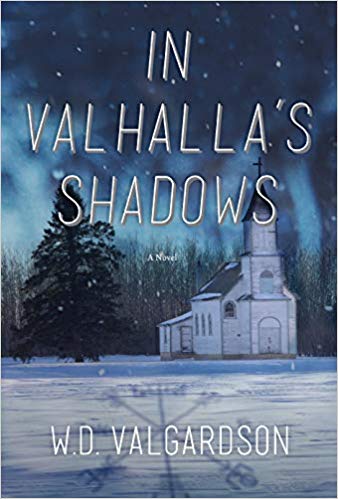In Valhalla’s Shadows: A Novel
- By W.D. Valgardson
- Douglas & McIntyre
- 480 pp.
- Reviewed by Ruben Castaneda
- August 27, 2019
An atmospheric Canadian thriller that subtly comments on institutional abuses and racism.

Tom Parsons is depressed, understandably so. A former member of the Royal Canadian Mounted Police, he lost his career and the full use of one leg thanks to an on-the-job injury sustained during a catastrophic effort to capture a fleeing suspect.
His marriage is kaput, his soon-to-be ex has taken up with another man. To varying degrees, Tom is estranged from his young-adult children: bright, Goth, kickboxing daughter Myrna and son Joel, who may be suffering from a fatal disease.
Tom’s emotional scars cut deeper than his physical ones. He’s haunted by the terrible things he’s seen on the job, the bodies mangled in traffic wrecks, the corpses of people murdered, often by loved ones. Worst of all, he can’t shake the memory of his own police chase that led to the loss of an innocent life and his own maiming.
When he was on the force, Tom and his family lived wherever the job posted him. Now, with everything important to him gone or receding, he leaves his basement apartment in Winnipeg and lands in Valhalla, a seemingly quaint, picturesque lakeside fishing village. He buys an old house and a spot of land and tries to carry on with his life.
Before long, his plan to quietly blend into the background is derailed when he finds the body of a teenage Indigenous girl named Angel face-down on the lakeshore. Was she murdered? Did she take her own life? Was her death an accident?
The discovery — and the fact that many of Valhalla’s inhabitants quickly begin to talk among themselves, speculating whether the newcomer had anything to do with Angel’s demise — spurs Tom to investigate, slowly, around the edges.
Valhalla’s residents don’t expect more than a cursory response from Tom’s former police colleagues, and the RCMP delivers just that. But, over the course of nearly 500 pages, author W.D. Valgardson shows Tom putting enough pieces together to learn the truth.
It would be inaccurate to label In Valhalla’s Shadows a straight mystery or detective story. This isn’t a typical wounded-ex-cop procedural. It’s not plot-driven and propulsive like James Ellroy’s L.A. Confidential or sprawling like Don Winslow’s Power of the Dog series (The Power of the Dog, The Cartel, and The Border). Valhalla’s narrative is at least as much about the village — its citizens, subculture, and history — as it is about resolving Angel’s death.
Tom (and the reader) encounters a religious group with cultish, Viking undertones; an older local woman, Sarah, who befriends Tom and teaches him about area customs and history; and two attractive women who put the moves on the ex-cop.
Many of the townspeople are of Icelandic descent, which is depicted by the foods they eat and some of the lore they share. The village’s weather is a character, too — it’s a place of extremes, either bone-chillingly cold or oppressively hot.
And despite his initial instinct to keep to himself, Tom is slowly drawn to Freyja, the younger of the women making moves on him. This attraction has its own complications.
In her teens, Freyja married and divorced twice. Her second ex, Siggi, a washed-up local hockey hero who never made it big, is now a small-time drug dealer who won’t let his former wife go completely. Siggi can be charismatic and generous, and also inventively menacing, as his choice of bodyguards for his grow compound attests. (The members of his security force are locals, but they have paws, not hands.)
The story also explores casual and systemic racism. For example, it’s easy for the RCMP to write off the death of an Indigenous girl from a poor family. Tom recalls various instances of how, when he was a cop, he saw two distinct brands of justice for people with wealth versus those without it.
Valgardson is a master at writing geographical locations. He skillfully describes the woods around Valhalla, its lake, and culverts. There are moments when it feels like the author goes overboard, though. More than halfway into the book, he spends two-plus pages describing a sudden storm. It’s a compelling scene, but one that probably didn’t require quite so many words. A minor quibble, overall.
The story picks up speed considerably in the latter half, as Tom keeps asking questions, pushing to solve the mystery of Angel’s death, putting a piece of the puzzle together here, another one there. People close to Angel provide information that could explain what happened to her, if only Tom can follow and connect the various threads.
Like Tom, the people who inhabit Valhalla have messy lives, secrets, regrets, and unrequited dreams. Happily, the novel’s ending provides them and the reader a well-earned sliver of hope.
Ruben Castaneda is the author of S Street Rising: Crack, Murder and Redemption in D.C. For 22 years, he primarily covered crime and the criminal justice system for the Washington Post. Castaneda is a health writer at U.S. News and World Report.

